Reading and Writing Toolkit
VerifiedAdded on 2022/11/18
|6
|1231
|53
AI Summary
This toolkit provides strategies for teaching reading and writing to students of all levels. It includes a chart of standards-based concepts, differentiated strategies, and materials/resources needed for implementation. The reflection section discusses the importance of inclusion and the use of contemporary resources and peer learning.
Contribute Materials
Your contribution can guide someone’s learning journey. Share your
documents today.
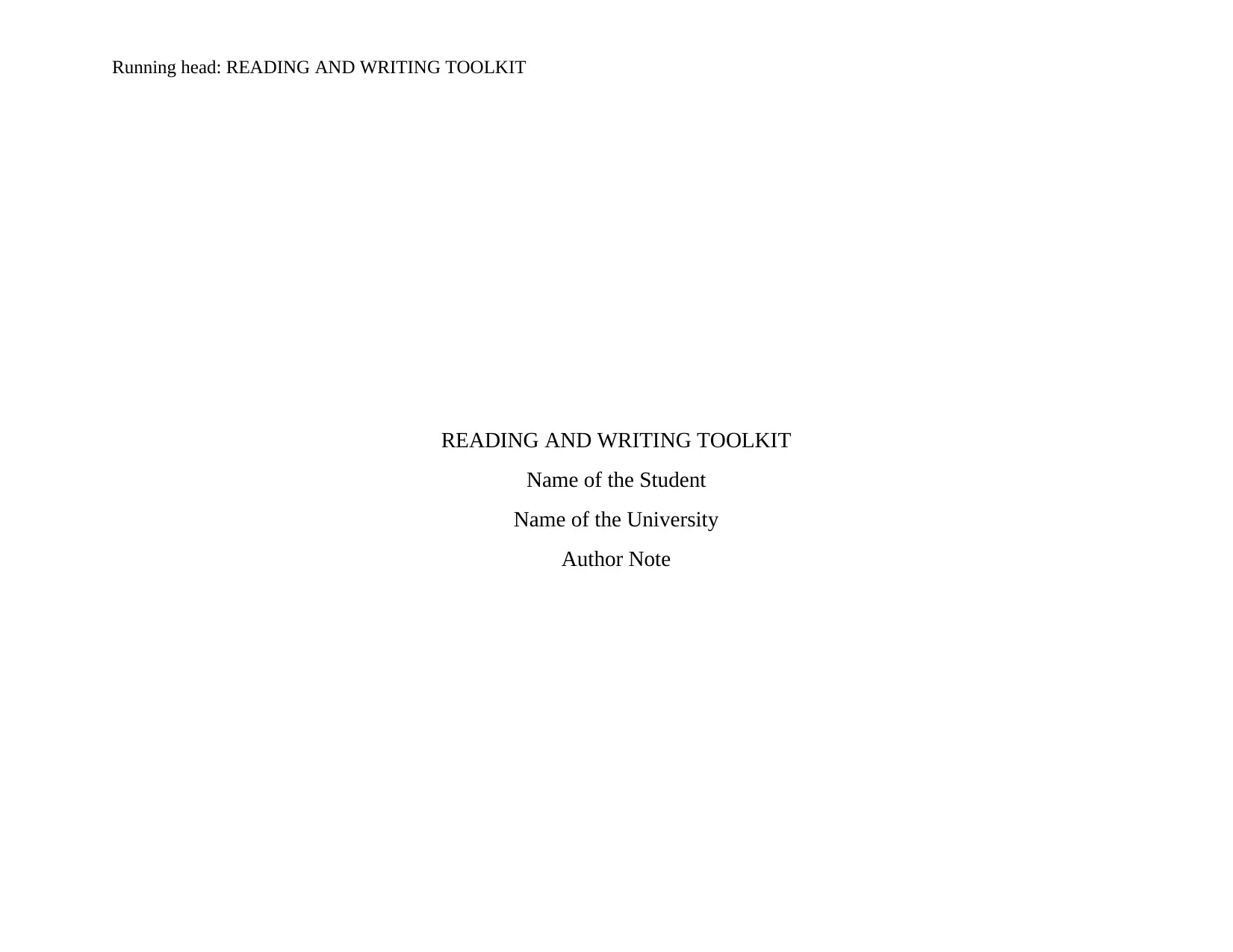
Running head: READING AND WRITING TOOLKIT
READING AND WRITING TOOLKIT
Name of the Student
Name of the University
Author Note
READING AND WRITING TOOLKIT
Name of the Student
Name of the University
Author Note
Secure Best Marks with AI Grader
Need help grading? Try our AI Grader for instant feedback on your assignments.
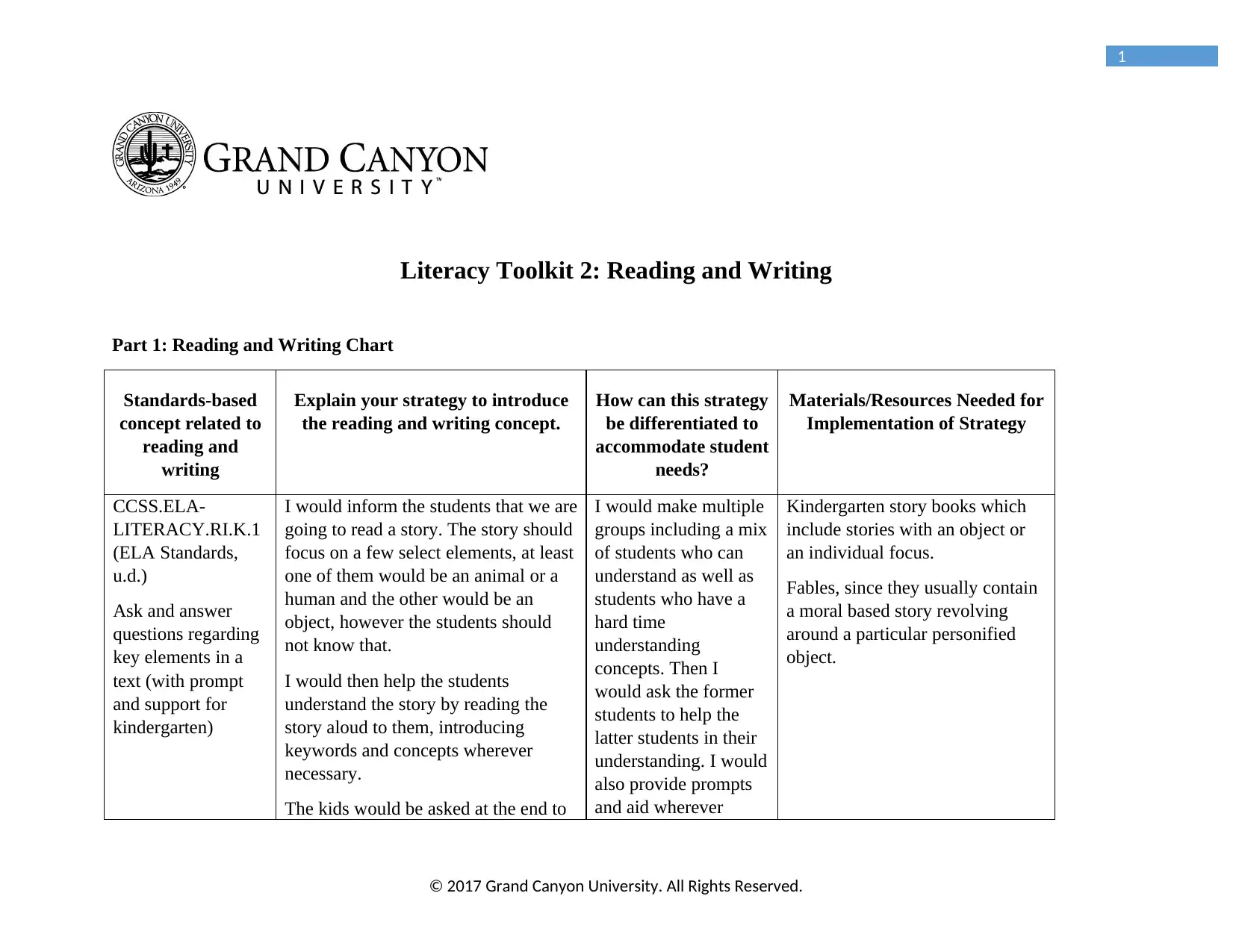
1
Literacy Toolkit 2: Reading and Writing
Part 1: Reading and Writing Chart
Standards-based
concept related to
reading and
writing
Explain your strategy to introduce
the reading and writing concept.
How can this strategy
be differentiated to
accommodate student
needs?
Materials/Resources Needed for
Implementation of Strategy
CCSS.ELA-
LITERACY.RI.K.1
(ELA Standards,
u.d.)
Ask and answer
questions regarding
key elements in a
text (with prompt
and support for
kindergarten)
I would inform the students that we are
going to read a story. The story should
focus on a few select elements, at least
one of them would be an animal or a
human and the other would be an
object, however the students should
not know that.
I would then help the students
understand the story by reading the
story aloud to them, introducing
keywords and concepts wherever
necessary.
The kids would be asked at the end to
I would make multiple
groups including a mix
of students who can
understand as well as
students who have a
hard time
understanding
concepts. Then I
would ask the former
students to help the
latter students in their
understanding. I would
also provide prompts
and aid wherever
Kindergarten story books which
include stories with an object or
an individual focus.
Fables, since they usually contain
a moral based story revolving
around a particular personified
object.
© 2017 Grand Canyon University. All Rights Reserved.
Literacy Toolkit 2: Reading and Writing
Part 1: Reading and Writing Chart
Standards-based
concept related to
reading and
writing
Explain your strategy to introduce
the reading and writing concept.
How can this strategy
be differentiated to
accommodate student
needs?
Materials/Resources Needed for
Implementation of Strategy
CCSS.ELA-
LITERACY.RI.K.1
(ELA Standards,
u.d.)
Ask and answer
questions regarding
key elements in a
text (with prompt
and support for
kindergarten)
I would inform the students that we are
going to read a story. The story should
focus on a few select elements, at least
one of them would be an animal or a
human and the other would be an
object, however the students should
not know that.
I would then help the students
understand the story by reading the
story aloud to them, introducing
keywords and concepts wherever
necessary.
The kids would be asked at the end to
I would make multiple
groups including a mix
of students who can
understand as well as
students who have a
hard time
understanding
concepts. Then I
would ask the former
students to help the
latter students in their
understanding. I would
also provide prompts
and aid wherever
Kindergarten story books which
include stories with an object or
an individual focus.
Fables, since they usually contain
a moral based story revolving
around a particular personified
object.
© 2017 Grand Canyon University. All Rights Reserved.
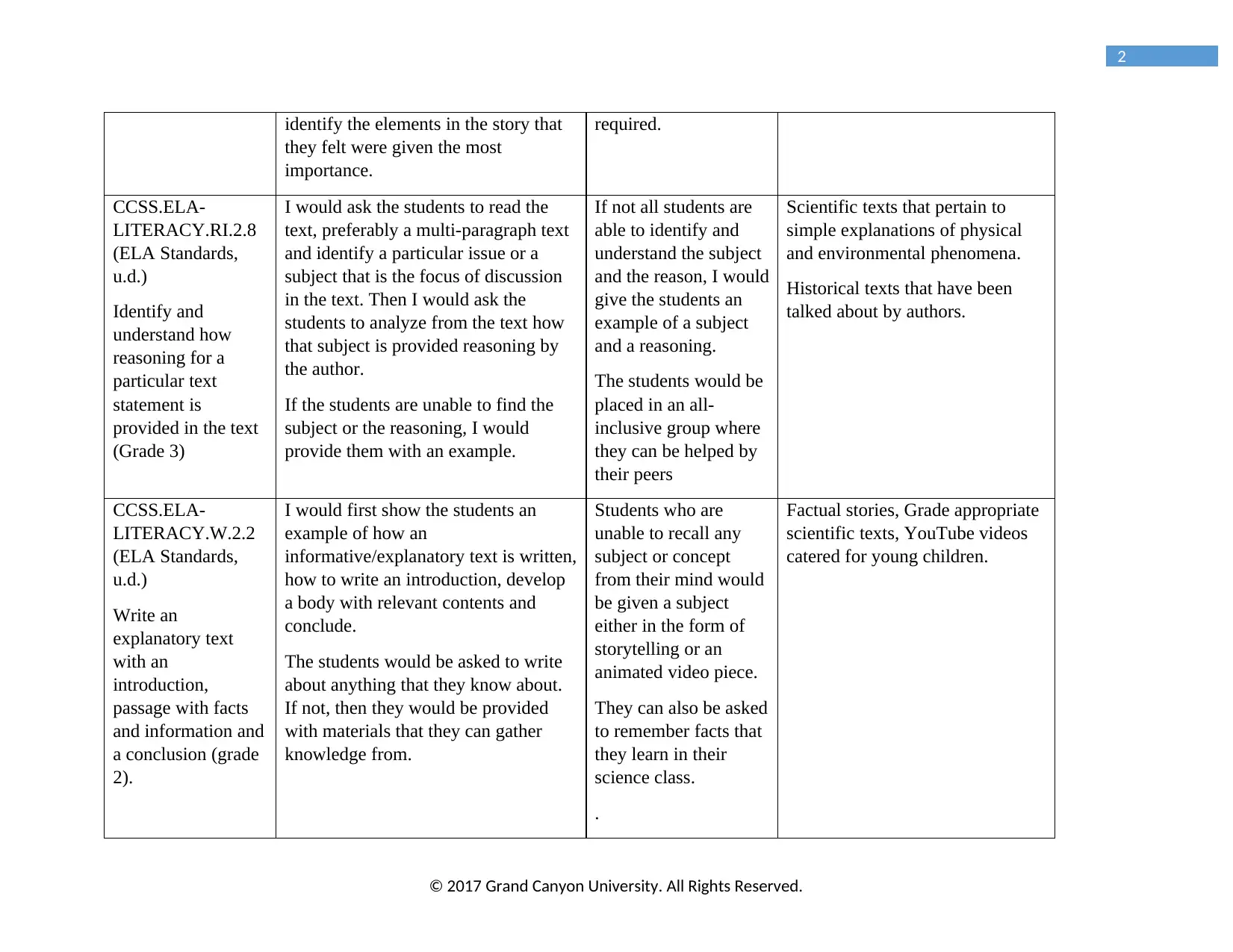
2
identify the elements in the story that
they felt were given the most
importance.
required.
CCSS.ELA-
LITERACY.RI.2.8
(ELA Standards,
u.d.)
Identify and
understand how
reasoning for a
particular text
statement is
provided in the text
(Grade 3)
I would ask the students to read the
text, preferably a multi-paragraph text
and identify a particular issue or a
subject that is the focus of discussion
in the text. Then I would ask the
students to analyze from the text how
that subject is provided reasoning by
the author.
If the students are unable to find the
subject or the reasoning, I would
provide them with an example.
If not all students are
able to identify and
understand the subject
and the reason, I would
give the students an
example of a subject
and a reasoning.
The students would be
placed in an all-
inclusive group where
they can be helped by
their peers
Scientific texts that pertain to
simple explanations of physical
and environmental phenomena.
Historical texts that have been
talked about by authors.
CCSS.ELA-
LITERACY.W.2.2
(ELA Standards,
u.d.)
Write an
explanatory text
with an
introduction,
passage with facts
and information and
a conclusion (grade
2).
I would first show the students an
example of how an
informative/explanatory text is written,
how to write an introduction, develop
a body with relevant contents and
conclude.
The students would be asked to write
about anything that they know about.
If not, then they would be provided
with materials that they can gather
knowledge from.
Students who are
unable to recall any
subject or concept
from their mind would
be given a subject
either in the form of
storytelling or an
animated video piece.
They can also be asked
to remember facts that
they learn in their
science class.
.
Factual stories, Grade appropriate
scientific texts, YouTube videos
catered for young children.
© 2017 Grand Canyon University. All Rights Reserved.
identify the elements in the story that
they felt were given the most
importance.
required.
CCSS.ELA-
LITERACY.RI.2.8
(ELA Standards,
u.d.)
Identify and
understand how
reasoning for a
particular text
statement is
provided in the text
(Grade 3)
I would ask the students to read the
text, preferably a multi-paragraph text
and identify a particular issue or a
subject that is the focus of discussion
in the text. Then I would ask the
students to analyze from the text how
that subject is provided reasoning by
the author.
If the students are unable to find the
subject or the reasoning, I would
provide them with an example.
If not all students are
able to identify and
understand the subject
and the reason, I would
give the students an
example of a subject
and a reasoning.
The students would be
placed in an all-
inclusive group where
they can be helped by
their peers
Scientific texts that pertain to
simple explanations of physical
and environmental phenomena.
Historical texts that have been
talked about by authors.
CCSS.ELA-
LITERACY.W.2.2
(ELA Standards,
u.d.)
Write an
explanatory text
with an
introduction,
passage with facts
and information and
a conclusion (grade
2).
I would first show the students an
example of how an
informative/explanatory text is written,
how to write an introduction, develop
a body with relevant contents and
conclude.
The students would be asked to write
about anything that they know about.
If not, then they would be provided
with materials that they can gather
knowledge from.
Students who are
unable to recall any
subject or concept
from their mind would
be given a subject
either in the form of
storytelling or an
animated video piece.
They can also be asked
to remember facts that
they learn in their
science class.
.
Factual stories, Grade appropriate
scientific texts, YouTube videos
catered for young children.
© 2017 Grand Canyon University. All Rights Reserved.
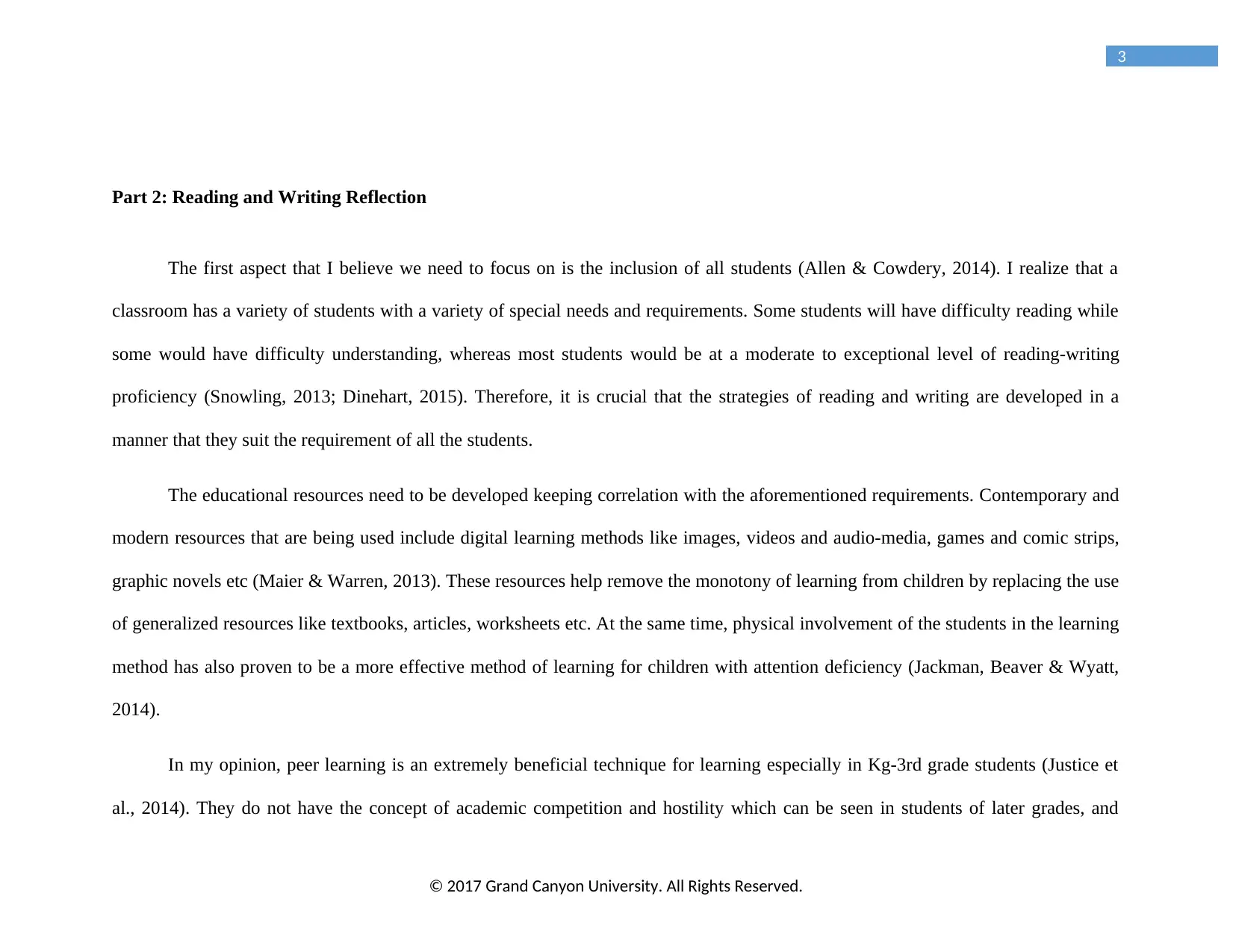
3
Part 2: Reading and Writing Reflection
The first aspect that I believe we need to focus on is the inclusion of all students (Allen & Cowdery, 2014). I realize that a
classroom has a variety of students with a variety of special needs and requirements. Some students will have difficulty reading while
some would have difficulty understanding, whereas most students would be at a moderate to exceptional level of reading-writing
proficiency (Snowling, 2013; Dinehart, 2015). Therefore, it is crucial that the strategies of reading and writing are developed in a
manner that they suit the requirement of all the students.
The educational resources need to be developed keeping correlation with the aforementioned requirements. Contemporary and
modern resources that are being used include digital learning methods like images, videos and audio-media, games and comic strips,
graphic novels etc (Maier & Warren, 2013). These resources help remove the monotony of learning from children by replacing the use
of generalized resources like textbooks, articles, worksheets etc. At the same time, physical involvement of the students in the learning
method has also proven to be a more effective method of learning for children with attention deficiency (Jackman, Beaver & Wyatt,
2014).
In my opinion, peer learning is an extremely beneficial technique for learning especially in Kg-3rd grade students (Justice et
al., 2014). They do not have the concept of academic competition and hostility which can be seen in students of later grades, and
© 2017 Grand Canyon University. All Rights Reserved.
Part 2: Reading and Writing Reflection
The first aspect that I believe we need to focus on is the inclusion of all students (Allen & Cowdery, 2014). I realize that a
classroom has a variety of students with a variety of special needs and requirements. Some students will have difficulty reading while
some would have difficulty understanding, whereas most students would be at a moderate to exceptional level of reading-writing
proficiency (Snowling, 2013; Dinehart, 2015). Therefore, it is crucial that the strategies of reading and writing are developed in a
manner that they suit the requirement of all the students.
The educational resources need to be developed keeping correlation with the aforementioned requirements. Contemporary and
modern resources that are being used include digital learning methods like images, videos and audio-media, games and comic strips,
graphic novels etc (Maier & Warren, 2013). These resources help remove the monotony of learning from children by replacing the use
of generalized resources like textbooks, articles, worksheets etc. At the same time, physical involvement of the students in the learning
method has also proven to be a more effective method of learning for children with attention deficiency (Jackman, Beaver & Wyatt,
2014).
In my opinion, peer learning is an extremely beneficial technique for learning especially in Kg-3rd grade students (Justice et
al., 2014). They do not have the concept of academic competition and hostility which can be seen in students of later grades, and
© 2017 Grand Canyon University. All Rights Reserved.
Secure Best Marks with AI Grader
Need help grading? Try our AI Grader for instant feedback on your assignments.
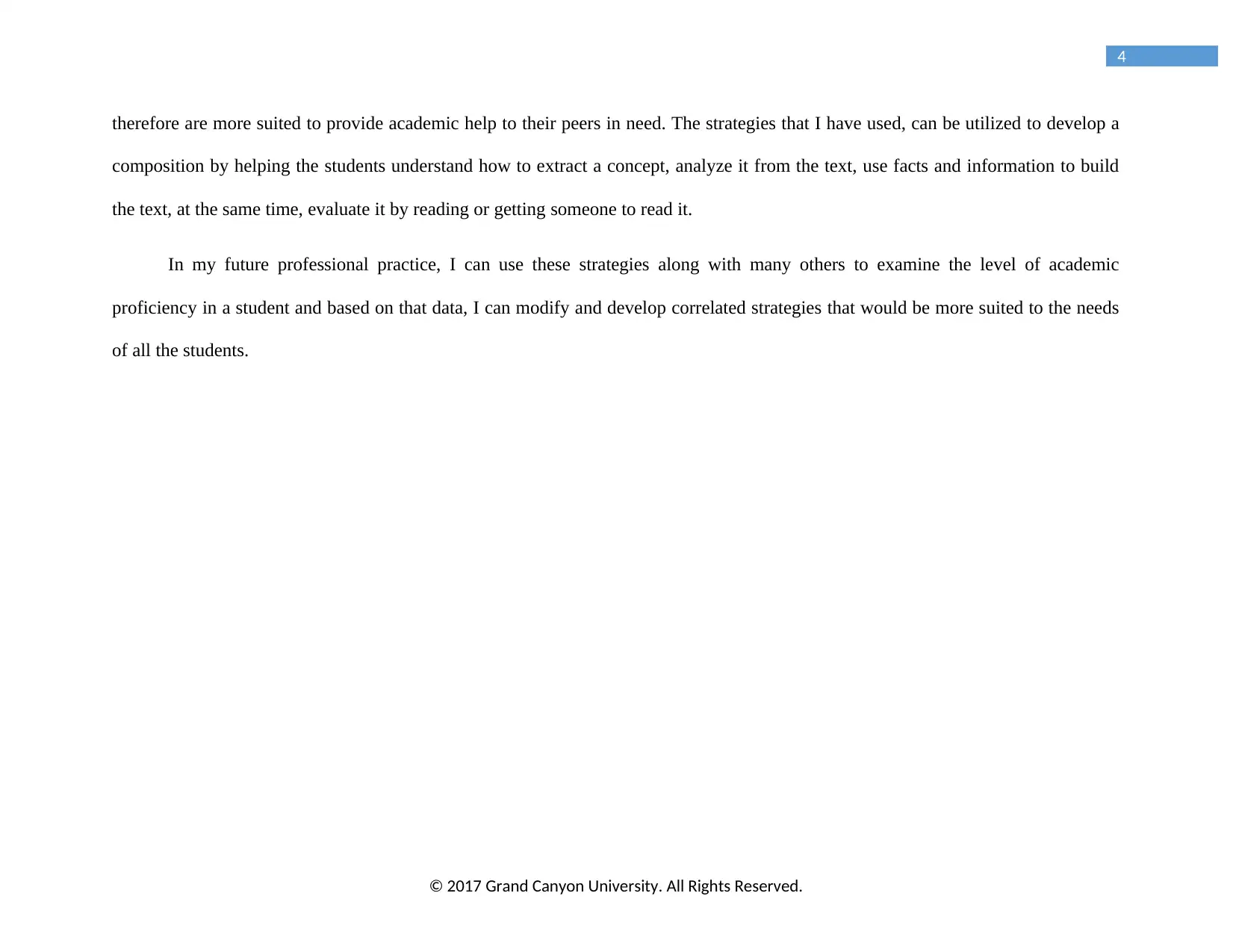
4
therefore are more suited to provide academic help to their peers in need. The strategies that I have used, can be utilized to develop a
composition by helping the students understand how to extract a concept, analyze it from the text, use facts and information to build
the text, at the same time, evaluate it by reading or getting someone to read it.
In my future professional practice, I can use these strategies along with many others to examine the level of academic
proficiency in a student and based on that data, I can modify and develop correlated strategies that would be more suited to the needs
of all the students.
© 2017 Grand Canyon University. All Rights Reserved.
therefore are more suited to provide academic help to their peers in need. The strategies that I have used, can be utilized to develop a
composition by helping the students understand how to extract a concept, analyze it from the text, use facts and information to build
the text, at the same time, evaluate it by reading or getting someone to read it.
In my future professional practice, I can use these strategies along with many others to examine the level of academic
proficiency in a student and based on that data, I can modify and develop correlated strategies that would be more suited to the needs
of all the students.
© 2017 Grand Canyon University. All Rights Reserved.
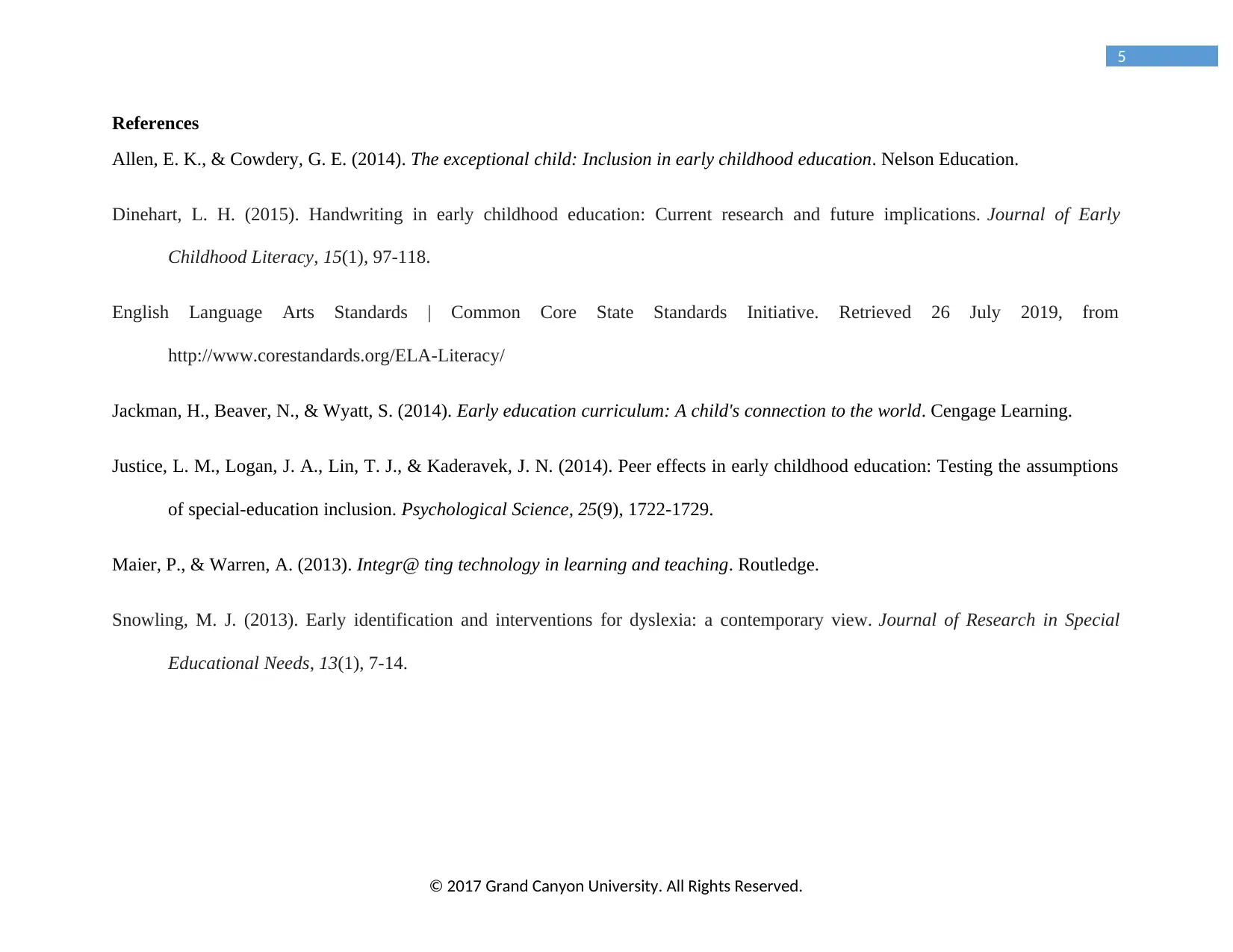
5
References
Allen, E. K., & Cowdery, G. E. (2014). The exceptional child: Inclusion in early childhood education. Nelson Education.
Dinehart, L. H. (2015). Handwriting in early childhood education: Current research and future implications. Journal of Early
Childhood Literacy, 15(1), 97-118.
English Language Arts Standards | Common Core State Standards Initiative. Retrieved 26 July 2019, from
http://www.corestandards.org/ELA-Literacy/
Jackman, H., Beaver, N., & Wyatt, S. (2014). Early education curriculum: A child's connection to the world. Cengage Learning.
Justice, L. M., Logan, J. A., Lin, T. J., & Kaderavek, J. N. (2014). Peer effects in early childhood education: Testing the assumptions
of special-education inclusion. Psychological Science, 25(9), 1722-1729.
Maier, P., & Warren, A. (2013). Integr@ ting technology in learning and teaching. Routledge.
Snowling, M. J. (2013). Early identification and interventions for dyslexia: a contemporary view. Journal of Research in Special
Educational Needs, 13(1), 7-14.
© 2017 Grand Canyon University. All Rights Reserved.
References
Allen, E. K., & Cowdery, G. E. (2014). The exceptional child: Inclusion in early childhood education. Nelson Education.
Dinehart, L. H. (2015). Handwriting in early childhood education: Current research and future implications. Journal of Early
Childhood Literacy, 15(1), 97-118.
English Language Arts Standards | Common Core State Standards Initiative. Retrieved 26 July 2019, from
http://www.corestandards.org/ELA-Literacy/
Jackman, H., Beaver, N., & Wyatt, S. (2014). Early education curriculum: A child's connection to the world. Cengage Learning.
Justice, L. M., Logan, J. A., Lin, T. J., & Kaderavek, J. N. (2014). Peer effects in early childhood education: Testing the assumptions
of special-education inclusion. Psychological Science, 25(9), 1722-1729.
Maier, P., & Warren, A. (2013). Integr@ ting technology in learning and teaching. Routledge.
Snowling, M. J. (2013). Early identification and interventions for dyslexia: a contemporary view. Journal of Research in Special
Educational Needs, 13(1), 7-14.
© 2017 Grand Canyon University. All Rights Reserved.
1 out of 6
Related Documents
Your All-in-One AI-Powered Toolkit for Academic Success.
+13062052269
info@desklib.com
Available 24*7 on WhatsApp / Email
![[object Object]](/_next/static/media/star-bottom.7253800d.svg)
Unlock your academic potential
© 2024 | Zucol Services PVT LTD | All rights reserved.





